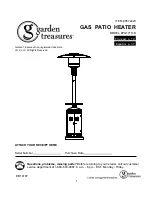
Page 22
4G. Cleaning the Heat Exchanger
CAUTION
Black carbon soot buildup on a dirty heat
exchanger can be ignited by a random spark
or flame. To prevent this happening, dampen
the soot deposits with a wet brush or fine
water spray before servicing the heat
exchanger. A light accumulation of soot or
corrosion on the outside of the tubes can be
easily removed with a wire brush after the heat
exchanger baffles are removed. Follow the
instructions in Section 5 to remove the heat
exchanger.
1.
Dry the heat exchanger completely.
2.
Remove the front and rear headers.
3.
Remove the tube baffles.
4.
The insides of the tubes can be reamed
(see Fig. 36).
NOTE:
Use only the correct carbide tipped reamers
which are available from Waterpik Technologies
Australia.
5.
Withdraw the reamer frequently to remove lime
powder and prevent the drill from binding in the
tube.
6.
Install new gaskets. Do not try to reuse the old
ones.
7.
Tighten the header bolts progressively, starting
with the two center bolts. Maximum torque is 27
newton-meters (Nm); do not overtighten.
An inspection and cleaning of the complete heat
exchanger can only be done by removing it from the
heater (see Section 5).
8.
Pressure test the heat exchanger for leaks.
9.
When placing the heat exchanger back in the
heater, be sure that the insulation strips are on
top of the side panels of the combustion chamber
and lower the heat exchanger into place.
10.
If a header bolt is stripped in the process of
reassembly, it can be driven out of the header
plate and replaced (see Section 6, Parts List).
4H. Automatic Flow Control Valve
The automatic flow control valve maintains the
correct flow of water through the heater over widely
varying filter flow conditions.
The valve has only one moving part, requires no
normal service, and will with stand normal pool water
for many years. Extremely high acid or chlorine
concentrations could damage valve parts which may
make it slow or inoperative. This might overheat the
water passing through the heater but fail to heat
enough water to raise the pool temperature to the
desired level.
If water in the heat exchanger is overheating
because of a sticky valve, the high limit switch will
open. If the automatic valve stays closed, too much
water passes through the heater causing too much
condensation on the tubes. Either condition can result
in poor heating.
The automatic valve can be tested by removing
the drain plug below the header casing and replacing it
with a thermometer inserted through a Pete's plug (see
Fig. 10).
When the filter pump is delivering a normal flow
to the heater, the thermometer should read a tempera-
ture within the range specified in Table 5.
Figure 35. Scale Inspection
Be sure tubes are dry
to make reaming easy
Figure 36. Heat Exchanger Cleaning
400-500 RPM
Drill Motor











































